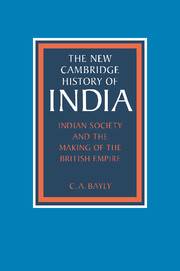Crossref Citations
This Book has been
cited by the following publications. This list is generated based on data provided by Crossref.
Mohanty, S.P.
1989.
Kipling's children and the colour line.
Race & Class,
Vol. 31,
Issue. 1,
p.
21.
Kearns, Gerry
1989.
Historical geography.
Progress in Human Geography,
Vol. 13,
Issue. 2,
p.
259.
Porter, Andrew
1990.
‘Gentlemanly capitalism’ and empire: The British experience since 1750?∗.
The Journal of Imperial and Commonwealth History,
Vol. 18,
Issue. 3,
p.
265.
Majeed, J.
1990.
James Mill's ‘The History of British India’ and Utilitarianism as a Rhetoric of Reform.
Modern Asian Studies,
Vol. 24,
Issue. 2,
p.
209.
Thomas, Nicholas
1991.
Against Ethnography.
Cultural Anthropology,
Vol. 6,
Issue. 3,
p.
306.
Price, Pamela G.
1991.
Acting in public versus forming a public: Conflict processing and political mobilization in nineteenth century South India.
South Asia: Journal of South Asian Studies,
Vol. 14,
Issue. 1,
p.
91.
ROBB, PETER
1992.
Peasants’choices? Indian agriculture and the limits of commercialization in nineteenth‐century Bihar1.
The Economic History Review,
Vol. 45,
Issue. 1,
p.
97.
1993.
Peasant Labour and Colonial Capital.
p.
140.
Hyam, Ronald
1993.
Britain’s Imperial Century, 1815–1914.
p.
134.
1993.
Peasant Labour and Colonial Capital.
p.
38.
1993.
Peasant Labour and Colonial Capital.
p.
1.
Hyam, Ronald
1993.
Britain’s Imperial Century, 1815–1914.
p.
1.
Marshall, P.J.
1993.
Retrospect on J.C. van Leur's Essay on the Eighteenth Century as a Category in Asian History.
Itinerario,
Vol. 17,
Issue. 1,
p.
45.
Perez, Rosa Maria
1994.
Reis e Intocáveis.
Raman, Kartik Kalyan
1994.
Utilitarianism and the Criminal Law in Colonial India: A Study of the Practical Limits of Utilitarian Jurisprudence.
Modern Asian Studies,
Vol. 28,
Issue. 4,
p.
739.
Porter, Andrew
1994.
European Imperialism, 1860–1914.
p.
59.
Assayag, Jackie
1994.
Homo Hierarchicus, Homo Symbolicus Approche structurale ou herméneutique en anthropologie sociale (de l'Inde) (note critique).
Annales. Histoire, Sciences Sociales,
Vol. 49,
Issue. 1,
p.
133.
Ingram, Edward
1995.
The Geopolitics of the first British expedition to Egypt – III: the Red Sea campaign, 1800–1.
Middle Eastern Studies,
Vol. 31,
Issue. 1,
p.
146.
SIVARAMAKRISHNAN, K.
1995.
Situating the Subaltern: History and Anthropology in the Subaltern Studies Project.
Journal of Historical Sociology,
Vol. 8,
Issue. 4,
p.
395.
Marshall, P. J.
1996.
Reappraisal: The rise of British power in Eighteenth‐century India.
South Asia: Journal of South Asian Studies,
Vol. 19,
Issue. 1,
p.
71.



